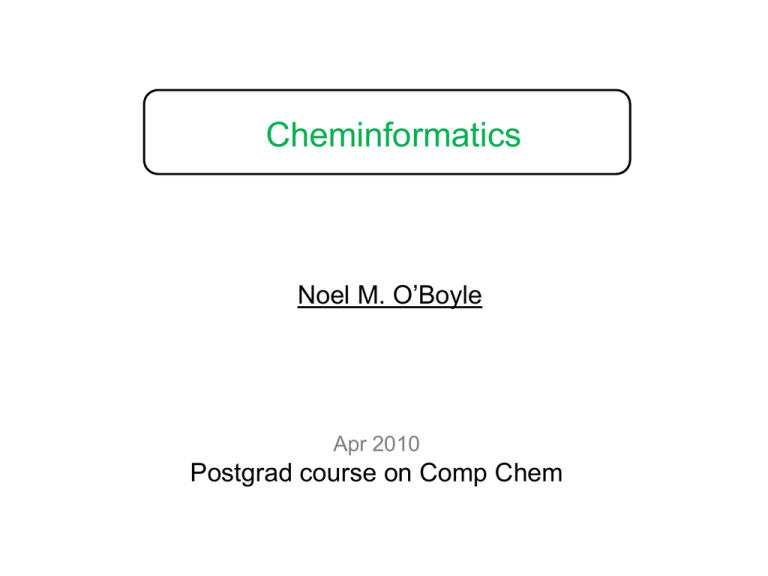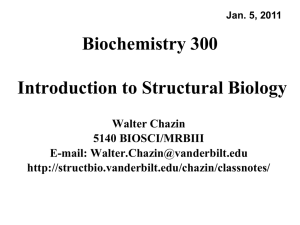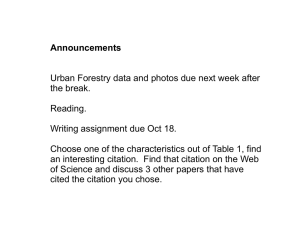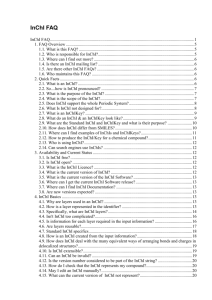
Cheminformatics
Noel M. O’Boyle
Apr 2010
Postgrad course on Comp Chem
Cheminformatics
• Hard to define in words:
– David Wild: “The field that studies all aspects of the representation and use
of chemical and related biological information on computers”
– Design, creation, organization, management, retrieval, analysis,
dissemination, visualization and use of chemical information
• Hard to agree on spelling:
– Sometimes chemoinformatics
• More easily thought of as encompassing a range of concepts
and techniques
–
–
–
–
–
–
–
–
Molecular similarity
Quantitative-structure activity relationships (QSAR)
Substructure search
(Automated) Molecular depiction
Encoding/decoding of molecular structures
3D structure generation from a 2D or 0D structure
Conformer generation
Algorithms: ring perception, aromaticity, isomers
References
• Cheminformatics, Johann Gasteiger
and Thomas Engel (Eds)
• Molecular modelling – Principles and
Applications, A. R. Leach
• I571 Chemical Information Technology,
David Wild, University of Indiana,
http://i571.wikispaces.com/
• An introduction to cheminformatics, A.
R. Leach, V. J. Gillet
Molecular representation
Mike Hann (GSK): “Ceci n'est pas une molecule serves
to remind us that all of the graphics images presented
here are not molecules, not even pictures of molecules,
but pictures of icons which we believe represent some
aspects of the molecule's properties.”
http://mgl.scripps.edu/people/goodsell/mgs_art/hann.html
Computer representations of molecules
• How can a molecular structure be stored
on a computer?
–
–
–
–
–
–
–
Common names: aspirin
IUPAC name: 2-acetoxybenzoic acid
Formula: C9H8O4
As an image (PNG, GIF, etc.)
CAS number: 50-78-2
File format: ChemDraw file, MOL file, etc.
SMILES string: O=C(Oc1ccccc1C(=O)O)C
– Binary Fingerprint:
10000100000001100000100100000001
• How should it be stored?
– ...if I want to find all molecules in a database
of 100K molecules that have a benzene ring?
– ...if I want a unique identifier?
Computer representations of molecules
• The structure of a molecule can be represented by
a graph
– Graph = collection of nodes and edges, nodes and
edges have properties (atomic number, bond order)
• Represent the molecular graph somehow
– Connection table (which nodes are connected to which
other nodes)
– Line notation (e.g. SMILES)
Chemical file formats
•
•
A large number of file formats have been developed
However there are certain de-facto standards
– MOL file for small-molecule structures
– PDB files for protein structures from crystallography
– MOL2 files for protein structures from modelling software (e.g. after manipulation
of the PDB file)
A chemical file format: MOL file
• This file format can represent 0D, 2D information (a
depiction) as well as 3D
SMILES format
• Simplified Molecular Input Line Entry System
– Weininger, J Chem Inf Comput Sci, 1988, 28, 31
– More recently, a community developed description:
http://opensmiles.org
– Linear format (“line notation”) that describes the connection table
and stereochemistry of a molecule (i.e. 0D)
– Convenient to enter as a query on-line, store in a database, pass
by email, etc.
• Examples:
– CC represents CH3CH3 (ethane)
– CC(=O)O represents CH3COOH (acetic acid)
• Basic guidelines:
– Hydrogens are implicit
– Parentheses indicate branches
– Each atom is connected to the preceding atom to its left (excluding
branches in-between)
– Single bonds are implicit, = for double, # for triple
• What is C(C)(C)(C)C?
SMILES format II
• To represent rings, you need to break a ring bond and replace it
by a ring opening symbol and a corresponding ring closure
symbol
Br
1 1
C
C
C1CCC=CC1
Cl
• To represent double bond stereochemistry you use / and \
• Cl/C=C/Br (trans), Cl/C=C\Br (cis)
• To represent tetrahedral stereochemistry you use @ or @@
• Br[C@](Cl)(I)F means that looking from the Br, the Cl, I, and
F are arranged anticlockwise
• To represent aromaticity, use lower case
• C1CCCCC1 (cyclohexane)
• c1ccccc1 (benzene)
Canonical SMILES
• In general, many different SMILES strings can
be written for the same molecule
– Not a unique identifier (one-to-many)
• Algorithms for producing “canonical SMILES”
have been developed
– The same unique SMILES string is always created
for a particular molecule
– One-to-one relationship between structure and
representation
– Note however, that different software implement
different canonicalisation algorithms
• Can be used to remove duplicate molecules
from a database
– Generate the canonical SMILES for each
molecule and ensure that they are unique
InChI
• International Chemical Identifier
– Line notation developed by NIST and IUPAC
– Goal: An index for uniquely identifying a molecule
•
Aspirin: InChI=1/C9H8O4/c1-6(10)13-8-5-3-2-4-7(8)9(11)12/h25H,1H3,(H,11,12)/f/h11H
• Features
– Derived from the structure (unlike CAS number)
– One-to-one relationship between InChI and structure
– Layers (of specificity)
• Can distinguish between stereoisomers, isotopes, or can leave out those
layers
– Different tautomeric forms give rise to the same InChI (unlike
SMILES)
• Notes
– Not human readable or writeable
– All implementations use the same (open source) code which is
provided by the InChI Trust
• “The Trust's goal is to enable the interlinking and combining of chemical,
biological and related information, using unique machine-readable chemical
structure representations to facilitate and expedite new scientific
discoveries.”
• See http://inchi.info and Google “unofficial inchi faq”
A unique identifier makes it easy to link databases
DrugBank
ChEBI
US Generic Legislation
•
•
•
Comprehensive Drug Abuse and Control Act, 1970
Controlled Substances Act, 1970
Federal Analog Act, 1986
•
The term “controlled substance analog” means a substance
–
The chemical structure of which is substantially similar to the chemical structure of a
controlled substance in schedule I or II
Slide courtesy Dr. J.J. Keating
Molecular similarity
• Similarity principle:
– Structurally similar molecules tend to have similar
properties
• Properties: biological activity, solubility, color and so on
• If we can measure similarity somehow
– Can construct a distance matrix
• Distance = inverse of similarity
• Such matrices can be used to cluster compounds, to create
a 2D depiction showing the spread of molecular structures
in a dataset, to select a diverse subset
– Can use to find molecules in a database similar to a
particular query
• Can find unknown molecules with a similar property
– Can use to see whether a particular property is
correlated with molecular similarity
• ...But how to measure similarity?
– One way is using molecular fingerprints
Molecular fingerprints
• A molecular fingerprint is an encoding of the molecular structure
onto a (long) binary string
– 100100010000001011000000000001...
• Types: path-based fingerprint, key-based fingerprint
• Path-based fingerprints (e.g. Daylight fingerprint)
– Break the molecule up into all possible fragments of length 1, 2,
3...7
– Create a string representing each fragment
– Hash each string onto a number between 1 and 1024 (for example)
• Wikipedia: “A hash function is any well-defined procedure or mathematical
function that converts a large, possibly variable-sized amount of data into a
small datum, usually a single integer that may serve as an index to an array”
– Set the corresponding bit of the fingerprint to 1 (all others will be 0)
• Key-based fingerprint s(e.g. MACCS keys)
– A (long) list of pre-generated questions about a chemical structure
• “Are there fewer than 3 oxygens?”
• “Is there an S-S bond?”
• “Is there a ring of size 4?”
– Each answer, true or false, corresponds to a 1 or 0 in the binary
fingerprint
Similarity of molecular fingerprints
• Molecules with the same bits set will be more similar than
molecules with different bits set
• To quantify this, we can use the Tanimoto coefficient
– Similarity = Intersection/Union
– Bounded by 0 and 1 (no similarity to perfect similarity)
• A value of greater than 0.7 or 0.8 indicates structural
similarity
– Used as a cutoff value
• How similar are aspirin (A) and salicylic acid (B)?
•
Using a path-based fingerprint, 64 bits are set for A, 38 for B
• Intersection is 38 (Note: B is a substructure of A)
• Union is 64
• Similarity = 0.59
Similarity of atom environments
•
•
Fingerprints can also be used to measure similarity
of atom environments
Circular fingerprints (HOSE codes)
– Bremser, W., HOSE – a novel substructure code. Anal.
Chim. Acta 1978, 103, 355.
– Describe atom environment in terms of atom types at
various bond distances from a particular atom
•
Can be used for proton NMR prediction
– Hydrogens attached to similar atoms tend to have
similar NMR shifts
– Given a database of molecules with assigned NMR
spectra, try to find Hs in the same environment up to as
many levels as possible and use their NMR shifts to
predict the shift for your proton
•
The same database can be used for structure
identification
– Given a proton NMR spectrum, what chemical structures
are consistent with the NMR
•
NMRShiftDB (http://www.ebi.ac.uk/nmrshiftdb/)
– Freely available Open database of NMR spectra – add your own spectra (with assigned
peaks) – predict assignments
–
Tutorial: http://nmrshiftdb.sourceforge.net/nmrshiftdbebitraining.pdf











